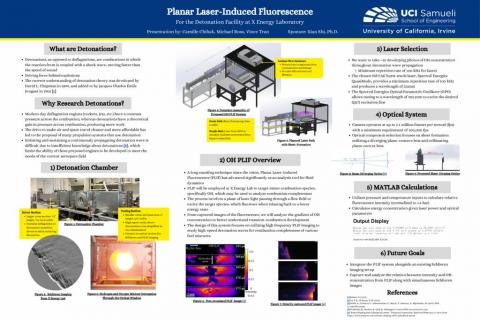Planar Laser Induced Fluorescence (PLIF) System for the Study of High-Speed Reacting Flows
Background
Detonation Research at X Energy Laboratory
Motivation from X Energy Lab: Emerging detonation-based propulsion concepts rely on stable and sustained detonation propagation controlled by small-scale shock-chemistry-wall interactions. While detonation has been widely studied in the context of cellular structures in idealized laboratory environments, the dynamics observed in practical detonation engines are often dramatically different as influenced by specific thermodynamic, mixing, and boundary conditions, shown in the figure below. There is a clear disconnect from the state of knowledge of detonation largely derived from studies of detonation cells to realistic detonation dynamics in engine applications.
To aid their goal of offering a unifying theory for detonation propagation of different structures and modalities, researchers at X Energy Lab aim to further characterize and understand detonation propagation by utilizing combustion diagnostics with their experimental setup. Our group will aid in their efforts by developing an additional diagnostic tool to integrate alongside their existing Schlieren imaging system.
Planar Laser-Induced Fluorescence
Planar Laser Induced Fluorescence (PLIF) is a technique utilized to examine and visualize combustion processes by specifically targeting molecules, such as hydroxyl (OH), within detonation chambers. Originally developed in the 1980s, PLIF technology has been extensively applied in various domains, including combustion diagnostics and jet fuel evaluation in the aerospace sector. Utilizing a pump laser and a wavelength tuner, the wavelength must be specifically tailored to sufficiently excite the OH species for maximum fluorescence. This technique employs a high-speed camera to detect the fluorescence emitted by OH molecules when they are excited by a laser. The analysis of the captured gradient provides detailed insights into the completeness and development of the combustion process.
Goal
The project's objective is to develop a PLIF diagnostic system designed for integration into a high-speed reacting flow facility focusing on supersonic detonation waves. The system is designed for seamless integration, ensuring it does not disrupt existing diagnostics while aiming for high spatial and temporal resolution.
Objectives
Design Phase (1/26/24)
- Finalize CAD model for optical setup
- Obtain Sponsor’s Approval for setup
Analysis Phase (2/23/24)
- Run simulations for accurate specifications
- Analysis of PLIF images diagnostics
Manufacturing Phase (3/8/24)
- Construct visual model of intended PLIF system
- Demonstrate sheet-forming optics (beam divergence and collimation)
Documentation:
Technical Requirements:
The system requires a precise laser wavelength of 283.2 nm for OH concentration imaging of the Q1(7) excitation line. It must also support a laser with a minimum repetition rate of 100 kHz and a camera capable of operating at 100,000 or more frames per second. Compliance with US safety regulations for high-powered (Class 4) lasers is also a priority, guaranteeing safe operation. This initiative aims to enhance understanding of combustion processes in supersonic detonation waves, utilizing OH concentration analysis.
Future Plans:
Future objectives include further exploring Burst Mode Lasers (BML) and Optical Parametric Oscillators (OPO) to assess their performance relative to the traditional pump and dye lasers in PLIF systems. This exploration is prompted by the challenges posed by high-speed reaction flows, including the laser's maximum power constraint and the energy concentration of the laser sheet.
Team Contacts:
Michael Ross:
Vince Tran:
Camille Chihak:
Sponsor/Advisor:
Xian Shi, Ph.D.


